Refractivity Observations from Radar Phase Measurements: The 22 May 2002 Dryline Case during IHOP Project
Abstract
1. Introduction
2. Study Site and Data Sources
2.1. Study Area
2.2. Data Sources
3. Radar Refractivity Algorithm
Theoretical Background
4. Results
4.1. Kriging Interpolated Radar Refractivity Observations during the IHOP_2002 Project: Performance Analysis
4.2. Kriging Interpolated Radar Refractivity Maps: The 22 May 2002 Dryline Evolution
5. Discussion and Concluding Remarks
Author Contributions
Funding
Institutional Review Board Statement
Informed Consent Statement
Data Availability Statement
Acknowledgments
Conflicts of Interest
Abbreviations
| RMSE | Root Mean Square Error |
| UTC | Universal Time Coordinated |
| NCAR | National Center for Atmospheric Research |
| ISFF | Integrated Surface Flux Facility |
| AERI | Atmospheric Emitted Radiance Interferometer |
| IHOP | International Project |
| ECMWF | European Centre for Medium-Range Weather Forecast |
| ERA5 | ECMWF reanalysis v5 |
| NWP | Numerical Weather Prediction |
References
- Fujita, T. Structure and Movement of a Dry Front. Bull. Am. Meteorol. Soc. 1958, 39, 574–582. [Google Scholar] [CrossRef][Green Version]
- Rhea, J.O. A Study of Thunderstorm Formation Along Dry Lines. J. Appl. Meteorol. Climatol. 1966, 5, 58–63. [Google Scholar] [CrossRef]
- Ziegler, C.L.; Rasmussen, E.N. The Initiation of Moist Convection at the Dryline: Forecasting Issues from a Case Study Perspective. Weather Forecast. 1998, 13, 1106–1131. [Google Scholar] [CrossRef]
- Ziegler, C.L.; Lee, T.J.; Pielke, R.A. Convective initiation at the dryline: A modeling study. Mon. Weather Rev. 1997, 125, 1001–1026. [Google Scholar] [CrossRef]
- Parsons, D.B.; Shapiro, M.A.; Miller, E. The Mesoscale Structure of a Nocturnal Dryline and of a Frontal–Dryline Merger. Mon. Weather Rev. 2000, 128, 3824–3838. [Google Scholar] [CrossRef]
- Crook, N.A. Sensitivity of moist convection forced by boundary layer processes to low-level thermodynamic fields. Mon. Weather Rev. 1996, 124, 1767–1785. [Google Scholar] [CrossRef]
- Weckwerth, T.M.; Wilson, J.W.; Wakimoto, R.M. Thermodynamic Variability within the Convective Boundary Layer due to Horizontal Convective Rolls. Mon. Weather Rev. 1996, 124, 769–784. [Google Scholar] [CrossRef]
- Sun, J. Convective-scale assimilation of radar data: Progress and challenges. Q. J. R. Meteorol. Soc. 2005, 131, 3439–3463. [Google Scholar] [CrossRef]
- Gasperoni, N.A.; Xue, M.; Palmer, R.D.; Gao, J. Sensitivity of Convective Initiation Prediction to Near-Surface Moisture When Assimilating Radar Refractivity: Impact Tests Using OSSEs. J. Atmos. Ocean. Technol. 2013, 30, 2281–2302. [Google Scholar] [CrossRef]
- Ciesielski, P.E.; Johnson, R.H.; Haertel, P.T.; Wang, J. Corrected TOGA COARE Sounding Humidity Data: Impact on Diagnosed Properties of Convection and Climate over the Warm Pool. J. Clim. 2003, 16, 2370–2384. [Google Scholar] [CrossRef]
- Kuo, Y.H.; Sokolovskiy, S.V.; Anthes, R.A.; Vandenberghe, F. Assimilation of GPS radio occultation data for numerical weather prediction. Terr. Atmos. Ocean. Sci. 2000, 11, 157–186. [Google Scholar] [CrossRef]
- Bevis, M.; Businger, S.; Herring, T.A.; Rocken, C.; Anthes, R.A.; Ware, R.H. GPS Meteorology: Remote Sensing of Atmospheric Water Vapor Using the Global Positioning System. J. Geophys. Res. 1992, 97, 15787–15801. [Google Scholar] [CrossRef]
- UCAR/ATD. International H2O Project (IHOP_2002): Operations Plan. 2002. Available online: https://www.eol.ucar.edu/field_projects/ihop2002 (accessed on 12 December 2023).
- Weckwerth, T.M.; Parson, D.B.; Koch, S.E.; Moore, J.A.; LeMone, L.M.; Demoz, B.B.; Flamant, C.; Geerts, B.; Wang, J.; Feltz, W.F. An overview of the International H2O Project (IHOP_2002) and some preliminary highlights. Bull. Am. Meteorol. Soc. 2004, 85, 253–277. [Google Scholar] [CrossRef]
- Demoz, B.; Miller, D.; di Girolamo, P.; Whiteman, D.; Evans, K.; Flamant, C.; Geerts, B.; Weckwerth, T.; Starr, D.; Schwemmer, G.; et al. The 22 may Dryline in IHOP2002: The Role of Lidars in Quantifying the Convective Variability. In Proceedings of the 22nd Internation Laser Radar Conference (ILRC 2004), Matera, Italy, 12–16 July 2004; ESA Special Publication. Pappalardo, G., Amodeo, A., Eds.; Volume 561, p. 739. [Google Scholar]
- Demoz, B.B.; Flamant, C.; Weckwerth, T.M.; Whiteman, D.; Evans, K.; Fabry, F.; Girolamo, P.; Miller, D.; Geerts, B.; Brown, W.; et al. The Dryline on 22 May 2002 during IHOP_2002: Convective-Scale Measurements at the Profiling Site. Mon. Weather Rev. 2006, 134, 294–310. [Google Scholar] [CrossRef][Green Version]
- Weldegaber, M.H.; Demoz, B.B.; Sparling, L.C.; Hoff, R.; Chiao, S. Observational analysis of moisture evolution and variability in the boundary layer during the dryline on 22 May 2002. Meteorol. Atmos. Phys. 2010, 110, 87–102. [Google Scholar] [CrossRef]
- Weckwerth, T.M.; Parsons, D.B. A review of Convection Initiation and Motivation for IHOP_2002. Mon. Weather Rev. 2006, 134, 5–22. [Google Scholar] [CrossRef]
- Wakimoto, R.M.; Murphey, H.V.; Browell, E.V.; Ismail, S. The Triple Point on 24 May 2002 during IHOP. Part I: Airborne Doppler and LASE Analyses of the Frontal Boundaries and Convection Initiation. Mon. Weather Rev. 2006, 134, 231–250. [Google Scholar] [CrossRef]
- Cai, H.; Lee, W.C.; Weckwerth, T.M.; Flamant, C.; Murphey, H.V. Observations of the 11 June Dryline during IHOP_2002—A Null Case for Convection Initiation. Mon. Weather Rev. 2006, 134, 336–354. [Google Scholar] [CrossRef]
- Weckwerth, T.M.; Pettet, C.R.; Fabry, F.; Park, S.; LeMone, M.A.; Wilson, J.W. Radar refractivity retrieval: Validation and application to short-term forecasting. J. Appl. Meteorol. 2005, 44, 285–300. [Google Scholar] [CrossRef]
- Weiss, C.C.; Bluestein, H.B.; Pazmany, A.L. Finescale Radar Observations of the 22 May 2002 Dryline during the International H2O Project (IHOP). Mon. Weather Rev. 2006, 134, 273–293. [Google Scholar] [CrossRef]
- Wakimoto, R.M.; Murphey, H.V. Frontal and Radar Refractivity Analyses of the Dryline on 11 June 2002 during IHOP. Mon. Weather Rev. 2010, 138, 228–241. [Google Scholar] [CrossRef]
- Fabry, F.; Frush, C.; Zawadzki, I.; Kilambi, A. On the extraction of near-surface index of refraction using radar phase measurements from ground targets. J. Atmos. Ocean. Technol. 1997, 14, 978–987. [Google Scholar] [CrossRef]
- Fabry, F. Meteorological Value of Ground Target Measurements. J. Atmos. Ocean. Technol. 2004, 21, 560–573. [Google Scholar] [CrossRef]
- Lutz, J.P.; Lewis, E.; Loew, E.; Randall, M.; Van Andel, J. NCAR SPol: Portable polarimetric S-Band radar. In Proceedings of the Ninth Symposium on Meteorological Observations and Instrumentation, Charlotte, NC, USA, 27–31 March 1995; pp. 408–410. [Google Scholar] [CrossRef]
- Fabry, F. The Spatial Variability of Moisture in the Boundary Layer and its Effect on Convection Initiation: Project-Long Characterization. Mon. Weather Rev. 2006, 134, 978–987. [Google Scholar] [CrossRef]
- Buban, M.S.; Ziegler, C.L.; Rasmussen, E.N.; Richardson, Y.P. The Dryline on 22 May 2002 during IHOP: Ground-Radar and In Situ Data Analyses of the Dryline and Boundary Layer Evolution. Mon. Weather Rev. 2007, 135, 2473–2505. [Google Scholar] [CrossRef]
- Roberts, R.D.; Fabry, F.; Kennedy, P.C.; Nelson, E.; Wilson, J.; Rehak, N.; Fritz, J.; Chandrasekar, V.; Braun, J.; Sun, J.; et al. REFRACTT_2006: Real-Time retrieval of high-resolution low-level moisture fields from operational NEXRAD and research radars. Bull. Am. Meteorol. Soc. 2008, 89, 1535–1548. [Google Scholar] [CrossRef]
- Bodine, D.; Heinselman, P.L.; Cheong, B.L.; Palmer, R.D.; Michaud, D. A Case Study on the Impact of Moisture Variability on Convection Initiation Using Radar Refractivity Retrievals. J. Appl. Meteorol. Climatol. 2010, 49, 1766–1778. [Google Scholar] [CrossRef]
- Besson, L.; Caumont, O.; Goulet, L.; Bastin, S.; Menut, L.; Bresson, E.; Fourrie, N.; Fabry, F.; Parent du Chatelet, J. Comparison of real-time refractivity measurements by radar with automatic weather stations, AROME-WMED and WRF forecast simulations during SOP1 of the HyMeX campaign. Q. J. R. Meteorol. Soc. 2016, 142, 138–152. [Google Scholar] [CrossRef]
- Feng, Y.C.; Hsu, H.W.; Weckwerth, T.M.; Lin, P.L.; Liou, Y.C.; Wang, T.C.C. The Spatiotemporal Characteristics of Near-Surface Water Vapor in a Coastal Region Revealed from Radar-Derived Refractivity. Mon. Weather Rev. 2021, 149, 2853–2873. [Google Scholar] [CrossRef]
- Park, S.; Fabry, F. Simulation and interpretation of the phase data used by radar refractivity retrieval algorithm. J. Atmos. Ocean. Technol. 2010, 27, 1286–1301. [Google Scholar] [CrossRef]
- Feng, Y.; Fabry, F.; Weckwerth, T.M. Improving Radar Refractivity Retrieval by considering the change in the Refractivity Profile and the Varying Altitudes of Ground Targets. J. Atmos. Ocean. Technol. 2016, 33, 989–1004. [Google Scholar] [CrossRef]
- Nocelo, R.; Santalla, V. High Temporal Resolution Refractivity Retrieval from Radar Phase Measurements. Remote Sens. 2018, 10, 896. [Google Scholar] [CrossRef]
- Nocelo López, R.; Sánchez-Rama, B.; Santalla del Río, V.; Barbosa, S.; Narciso, P.; Pérez-Santalla, R.; Pettazzi, A.; Pinto, P.; Salsón, S.; Viegas, T. Refractivity and Refractivity Gradient Estimation From Radar Phase Data: A Least Squares Based Approach. IEEE Trans. Geosci. Remote Sens. 2023, 61, 5103214. [Google Scholar] [CrossRef]
- Sánchez-Rama, B.; Nocelo López, R.; Santalla Del Río, V.; Darlington, T. Radar-Based Refractivity Maps Using Geostatistical Interpolation. IEEE Geosci. Remote Sens. Lett. 2023, 20, 1–5. [Google Scholar] [CrossRef]
- UCAR/NCAR-Earth Observing Laboratory. S-Band/Ka-Band Polarimetric (S-PolKa) Data cfRadial Format, Version 1.0; UCAR/NCAR-Earth Observing Laboratory: Boulder, CO, USA, 1996; Retrieved 11 January 2015. [Google Scholar] [CrossRef]
- Bean, B.R.; Dutton, E.J. Radio Meteorology. Natl. Bur. Stand. Monogr. N. Y. Dover. 1968, 92, 435. [Google Scholar] [CrossRef]
- Feltz, W.F.; Howell, H.B.; Knuteson, R.O.; Woolf, H.M.; Revercomb, H.E. Near continuous profiling of temperature, moisture and atmospheric stability using the Atmospheric Emitted Radiance Interferometer (AERI). J. Appl. Meteorol. 2003, 42, 584–597. [Google Scholar] [CrossRef]
- Hersbach, H.; Bell, B.; Berrisford, P.; Hirahara, S.; Horányi, A.; Muñoz-Sabater, J.; Nicolas, J.; Peubey, C.; Radu, R.; Schepers, D.; et al. The ERA5 global reanalysis. Q. J. R. Meteorol. Soc. 2020, 146, 1999–2049. [Google Scholar] [CrossRef]
- Cheong, B.L.; Palmer, R.; Curtis, C.D.; Yu, T.Y.; Zrnic, D.S.; Forsyth, D. Refractivity Retrieval Using the Phased-Array Radar: First Results and Potential for Multimission Operation. IEEE Trans. Geosci. Remote Sens. 2008, 46, 2527–2537. [Google Scholar] [CrossRef]
- Chen, S.; Guo, J. Spatial interpolation techniques: Their applications in regionalizing climate-change series and associated accuracy evaluation in Northeast China. Geomat. Nat. Hazards Risk 2017, 8, 689–705. [Google Scholar] [CrossRef]
- Li, J.; Heap, A.D. A review of comparative studies of spatial interpolation methods in environmental sciences: Performance and impact factors. Ecol. Inform. 2011, 6, 228–241. [Google Scholar] [CrossRef]
- Webster, R.; Oliver, M.A. Geostatistics for Environmental Scientists; John Wiley & Sons: Hoboken, NJ, USA, 2007. [Google Scholar] [CrossRef]
- Wackernagel, H. Multivariate Geostatistics: An Introduction with Applications; Springer Science & Business Media: Berlin/Heidelberg, Germany, 2003. [Google Scholar] [CrossRef]

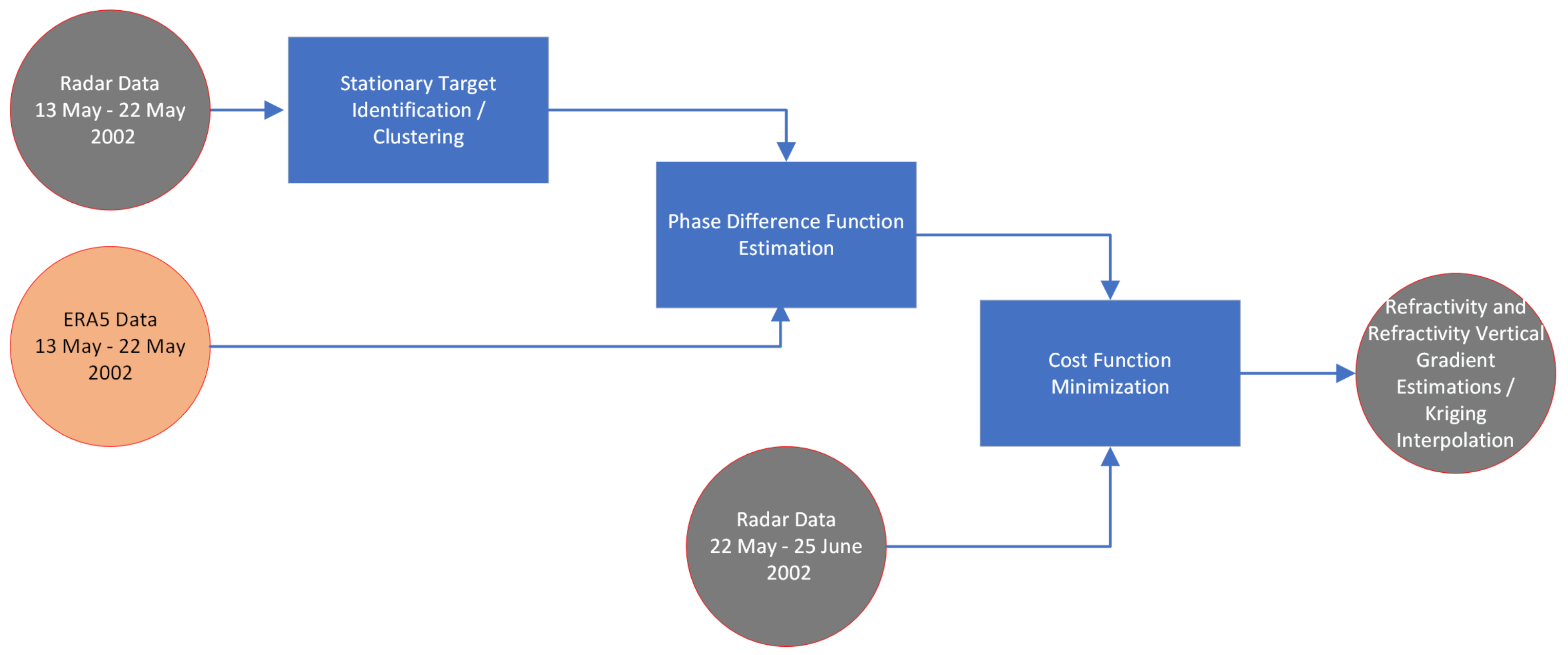
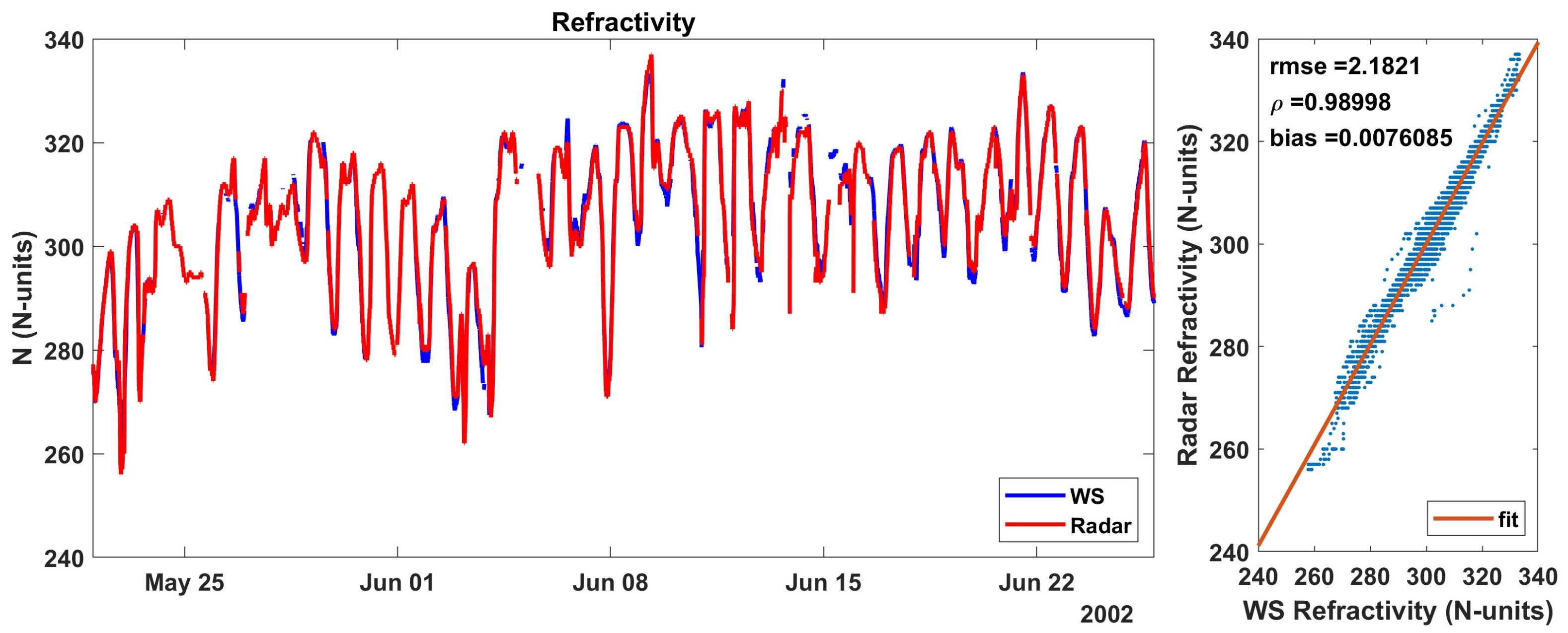
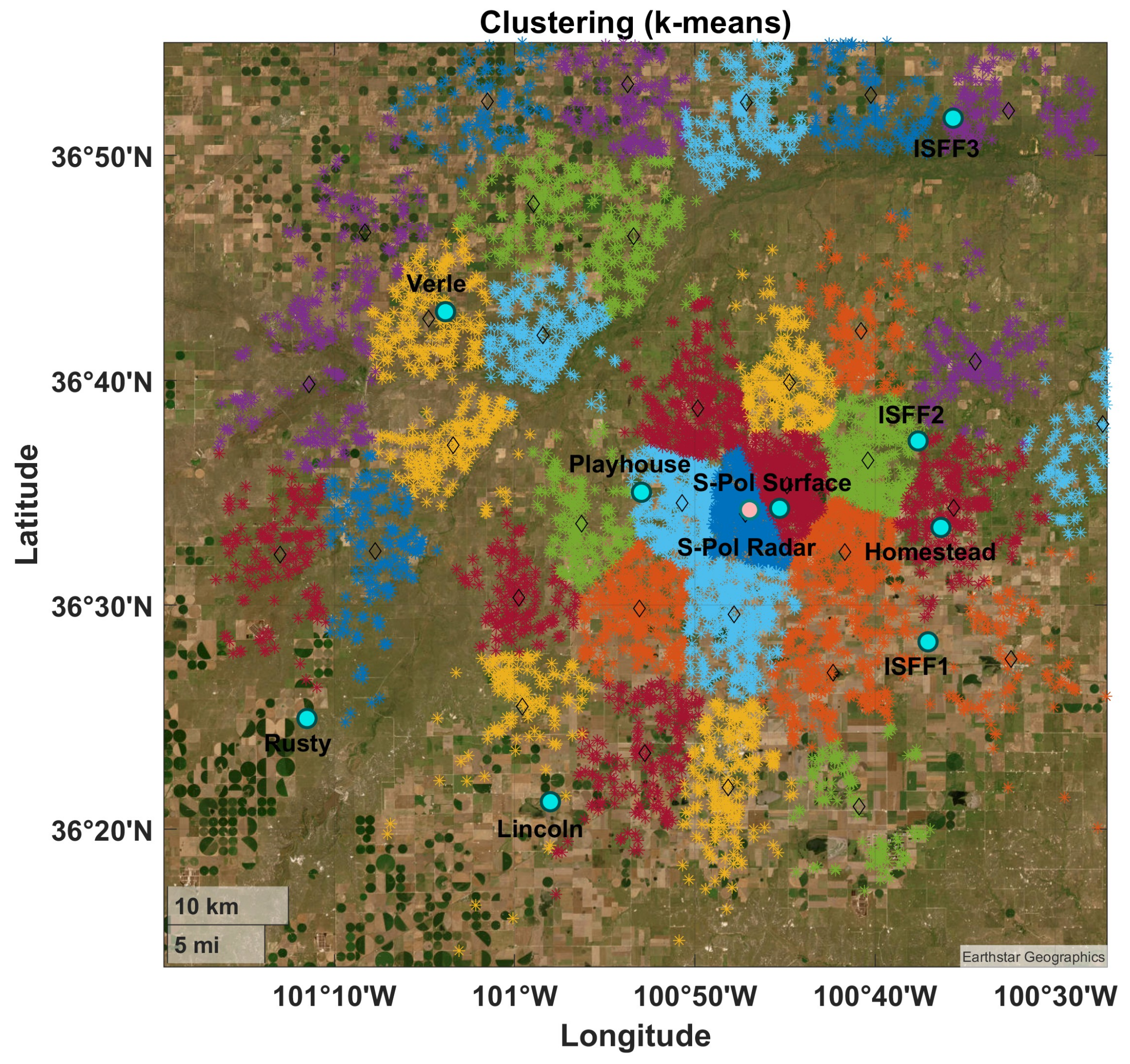
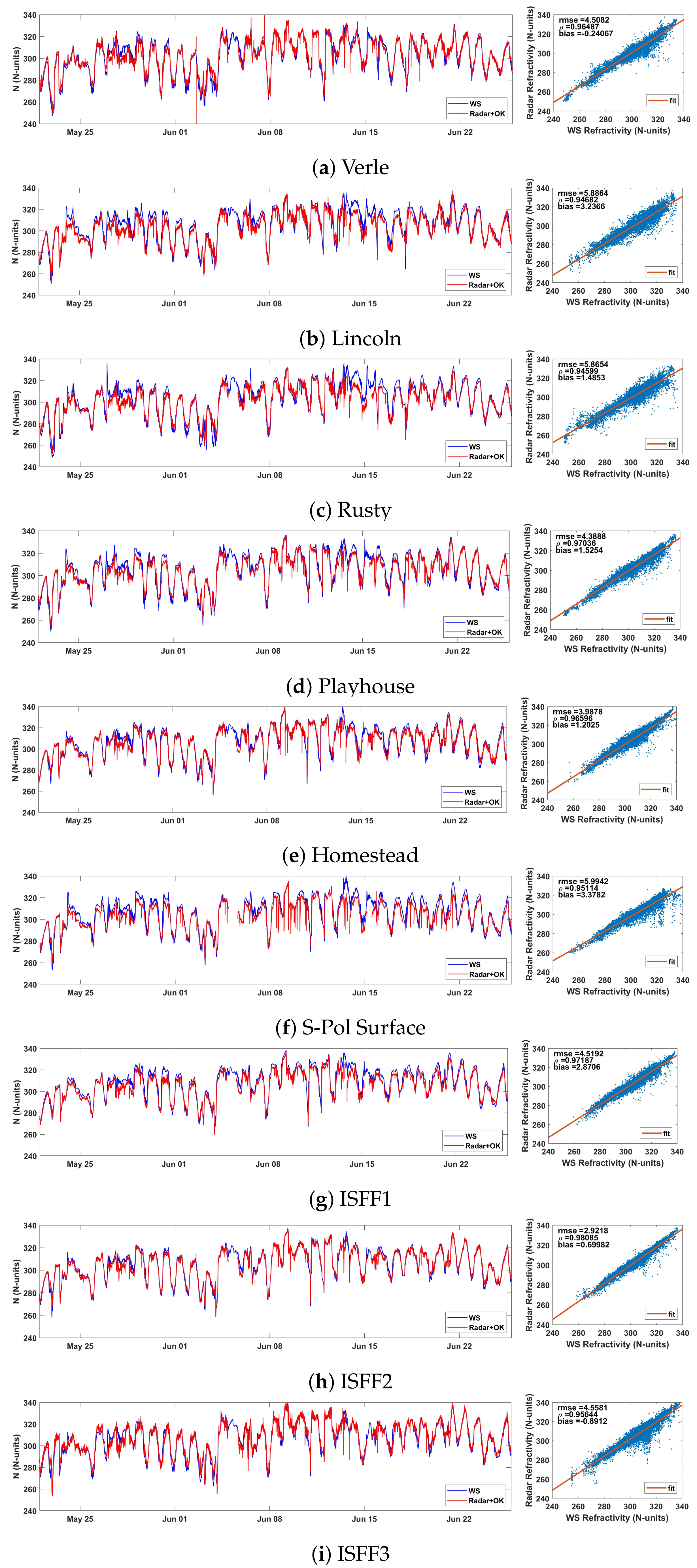
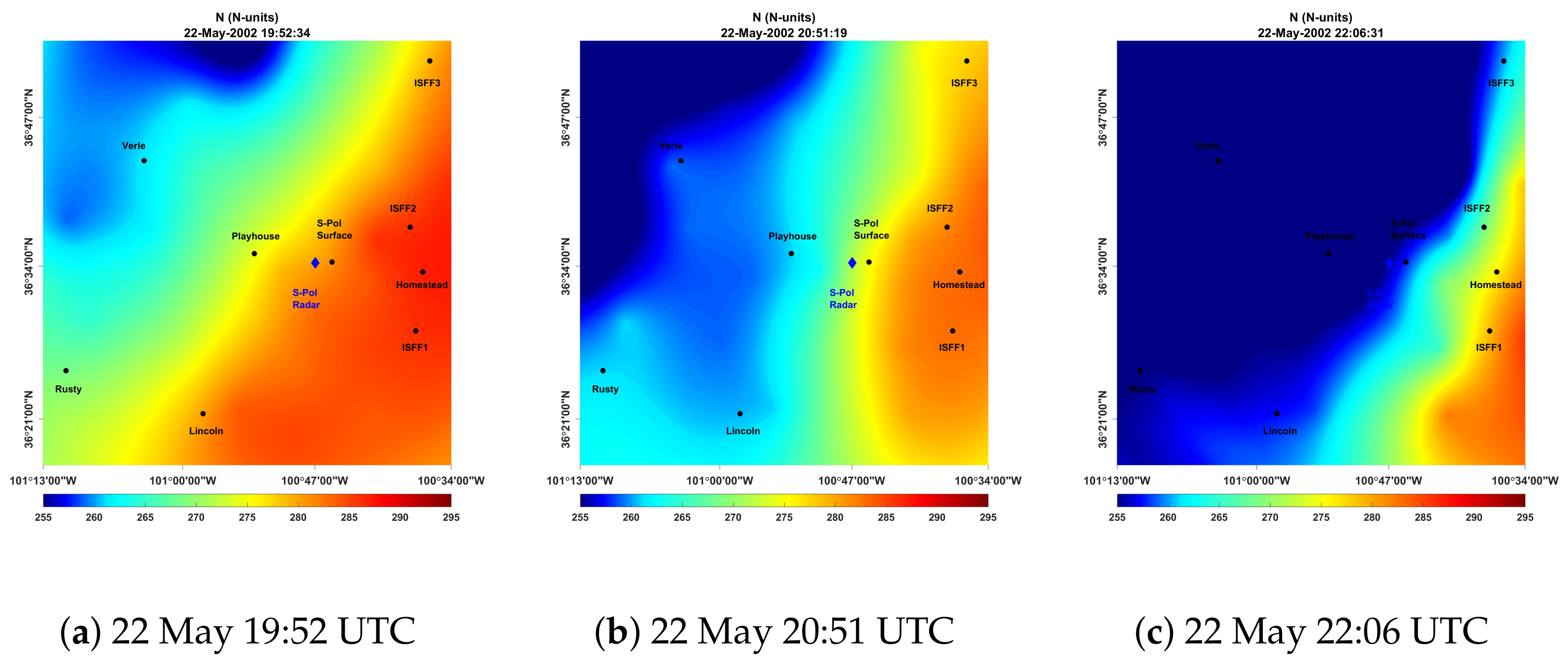

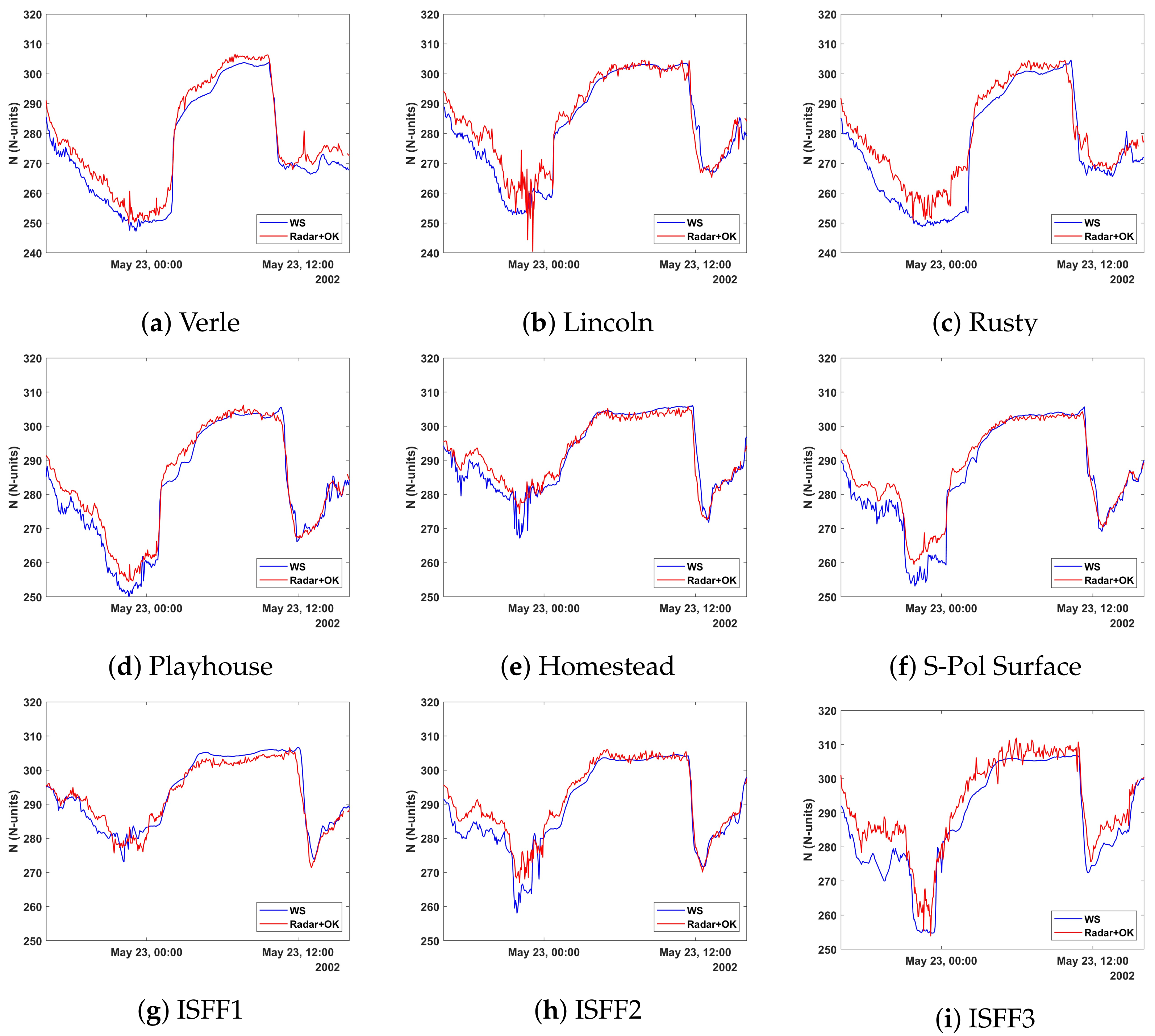
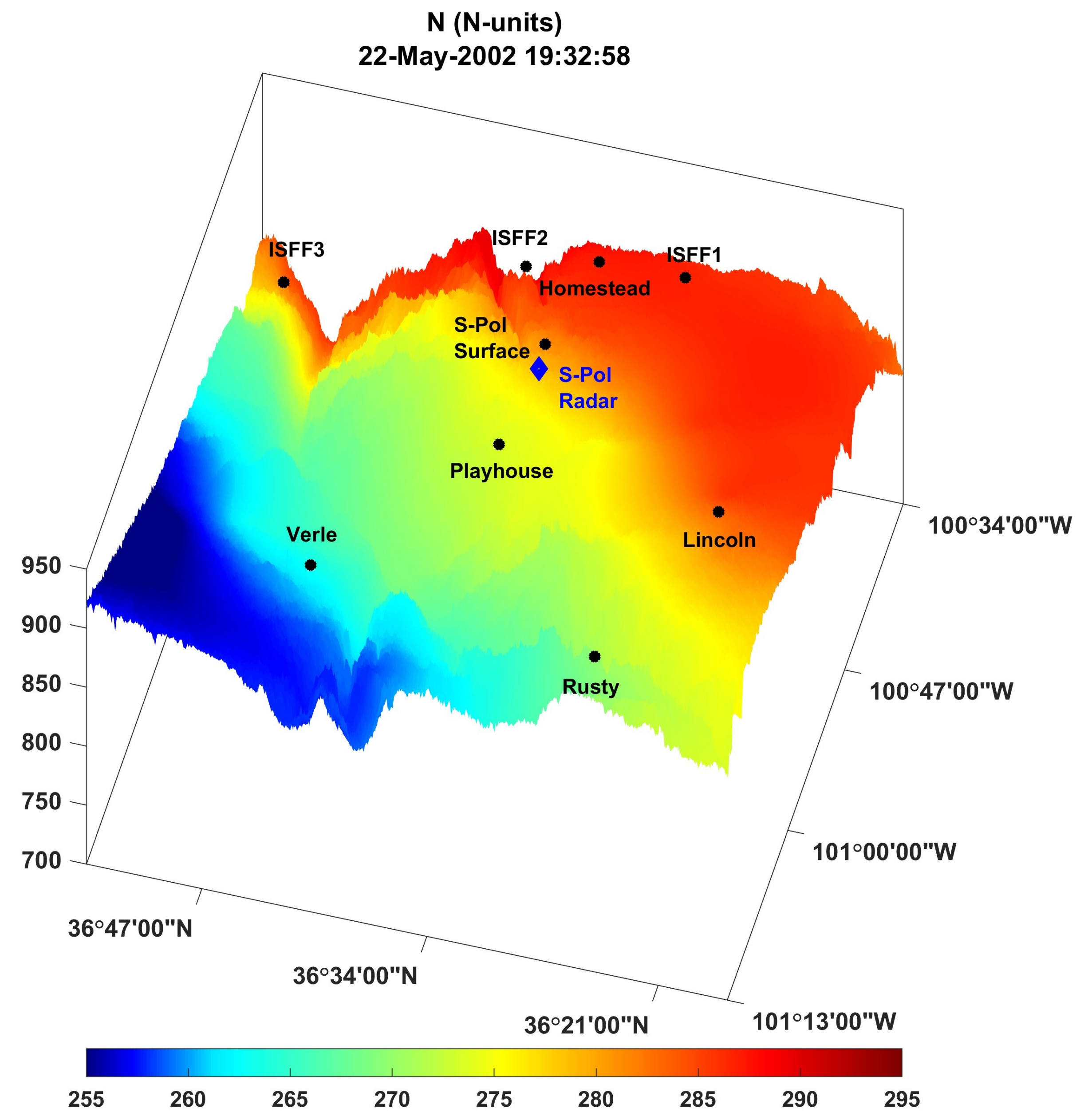
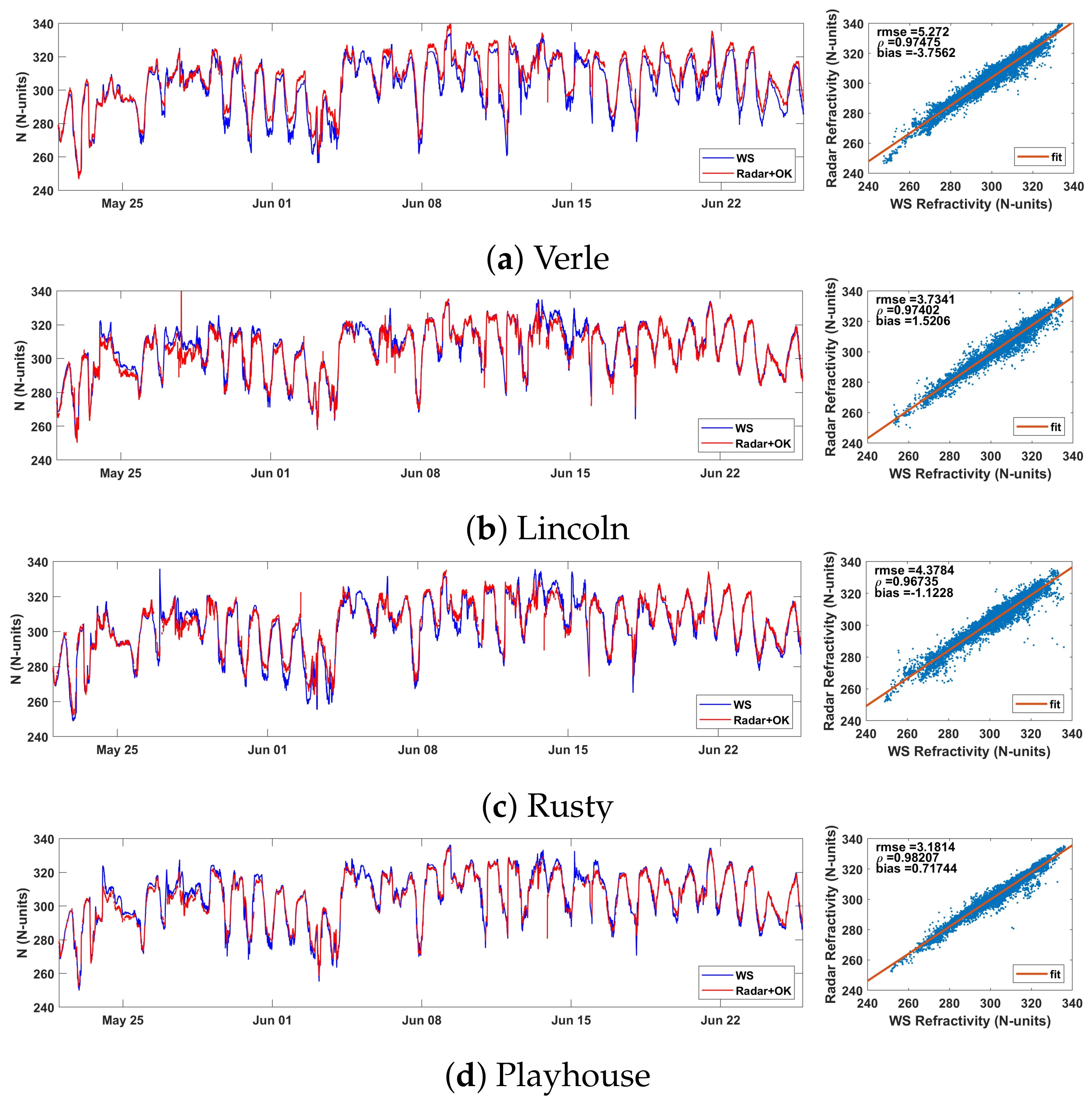
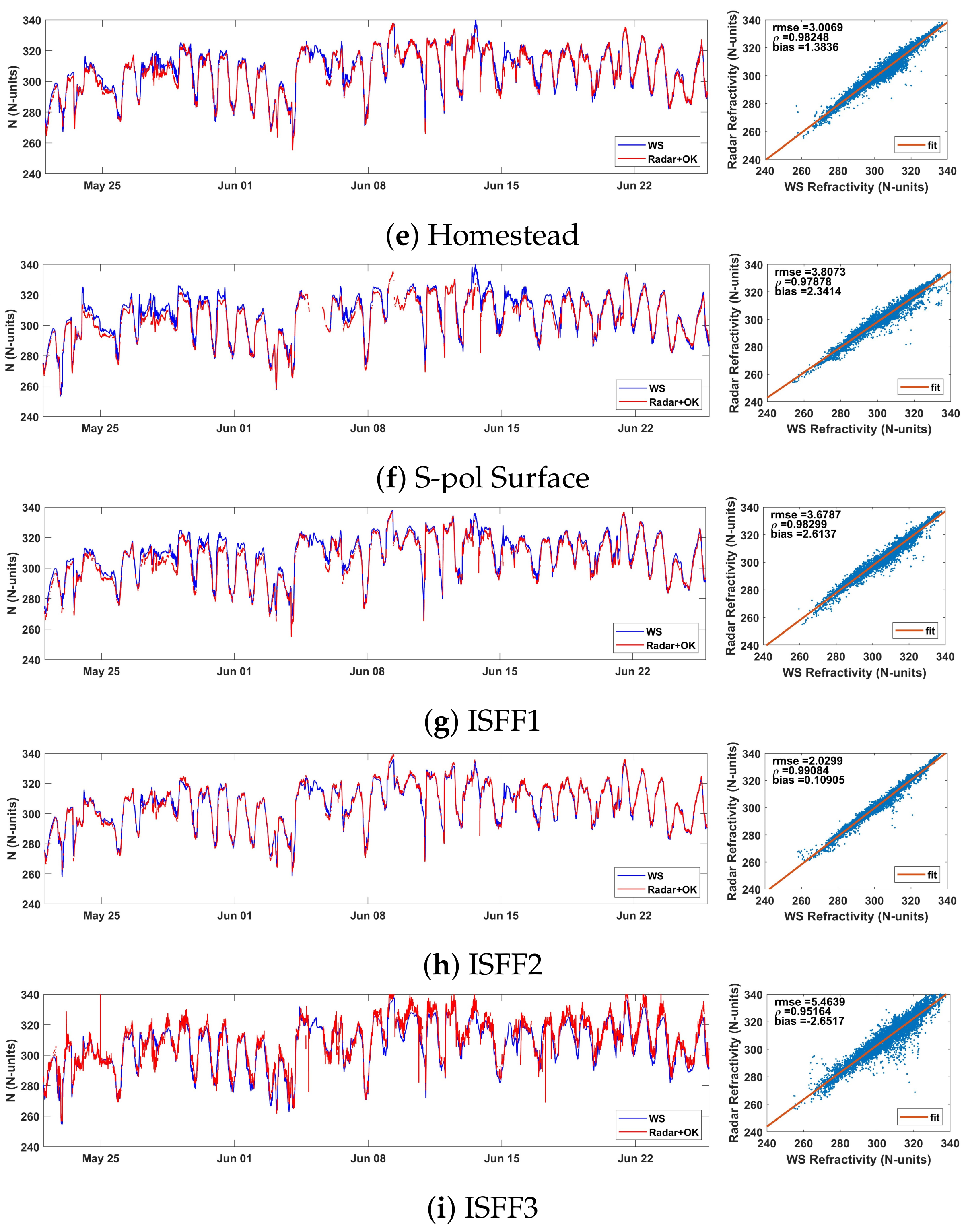
| Parameter | Value |
|---|---|
| Frequency | 2.8 GHz |
| Wavelength | 10 cm |
| Pulse-width | 0.994 s |
| Pulse repetition frequency (PRF) | 960 Hz |
| Range resolution | 150 m |
| Beam width | 0.918 |
| Scan-rate | 8.0/8.8/13.7/s |
| Samples | 110/100/64 |
| Scanning elevation angle | 0 |
| Noise Power | −114 dBm |
| Station | Longitude | Latitude | Altitude (m) | Distance (km) | Azimuth () |
|---|---|---|---|---|---|
| S-Pol Radar | 1004658 W | 363415 N | 875 | – | – |
| S-Pol Surface | 1004958 W | 363419 N | 883 | 2.5 | 89.44 |
| Verle | 1010350 W | 364304 N | 862 | 29.9 | 302.8 |
| Lincoln | 1005801 W | 362114 N | 915 | 29.3 | 214.1 |
| Rusty | 1011131 W | 362457 N | 922 | 40.43 | 244.5 |
| Playhouse | 1005258 W | 363502 N | 876 | 9.05 | 278.3 |
| Homestead | 1003621 W | 363328 N | 862 | 15.88 | 95.6 |
| ISFF1 | 1003704 W | 362822 N | 872 | 18.33 | 126.5 |
| ISFF2 | 1003737 W | 363719 N | 859 | 15.03 | 67.7 |
| ISFF3 | 1003540 W | 365139 N | 780 | 36.37 | 27.5 |
| Weather | RMSE | Bias | |
|---|---|---|---|
| Station | (N-Units) | (N-Units) | |
| Verle | 4.51 | 0.96 | −0.24 |
| Lincoln | 5.88 | 0.95 | 3.24 |
| Rusty | 5.86 | 0.95 | 1.48 |
| Playhouse | 4.39 | 0.97 | 1.52 |
| Homestead | 3.99 | 0.97 | 1.20 |
| S-Pol Surface | 5.99 | 0.95 | 3.38 |
| ISFF1 | 4.52 | 0.97 | 2.87 |
| ISFF2 | 2.92 | 0.98 | 0.70 |
| ISFF3 | 4.56 | 0.96 | −0.89 |
| Weather | RMSE | Bias | |
|---|---|---|---|
| Station | (N-Units) | (N-Units) | |
| Verle | 4.20 | 0.99 | −3.67 |
| Lincoln | 5.48 | 0.96 | −2.69 |
| Rusty | 6.93 | 0.97 | −4.19 |
| Playhouse | 3.57 | 0.99 | −2.34 |
| Homestead | 3.18 | 0.96 | −0.87 |
| S-Pol Surface | 4.06 | 0.98 | −2.48 |
| ISFF1 | 2.69 | 0.97 | 0.68 |
| ISFF2 | 3.93 | 0.98 | −2.48 |
| ISFF3 | 6.13 | 0.97 | −4.69 |
Disclaimer/Publisher’s Note: The statements, opinions and data contained in all publications are solely those of the individual author(s) and contributor(s) and not of MDPI and/or the editor(s). MDPI and/or the editor(s) disclaim responsibility for any injury to people or property resulting from any ideas, methods, instructions or products referred to in the content. |
© 2023 by the authors. Licensee MDPI, Basel, Switzerland. This article is an open access article distributed under the terms and conditions of the Creative Commons Attribution (CC BY) license (https://creativecommons.org/licenses/by/4.0/).
Share and Cite
López, R.N.; Rio, V.S.d.; Sánchez-Rama, B. Refractivity Observations from Radar Phase Measurements: The 22 May 2002 Dryline Case during IHOP Project. Atmosphere 2024, 15, 33. https://doi.org/10.3390/atmos15010033
López RN, Rio VSd, Sánchez-Rama B. Refractivity Observations from Radar Phase Measurements: The 22 May 2002 Dryline Case during IHOP Project. Atmosphere. 2024; 15(1):33. https://doi.org/10.3390/atmos15010033
Chicago/Turabian StyleLópez, Rubén Nocelo, Verónica Santalla del Rio, and Brais Sánchez-Rama. 2024. "Refractivity Observations from Radar Phase Measurements: The 22 May 2002 Dryline Case during IHOP Project" Atmosphere 15, no. 1: 33. https://doi.org/10.3390/atmos15010033
APA StyleLópez, R. N., Rio, V. S. d., & Sánchez-Rama, B. (2024). Refractivity Observations from Radar Phase Measurements: The 22 May 2002 Dryline Case during IHOP Project. Atmosphere, 15(1), 33. https://doi.org/10.3390/atmos15010033






